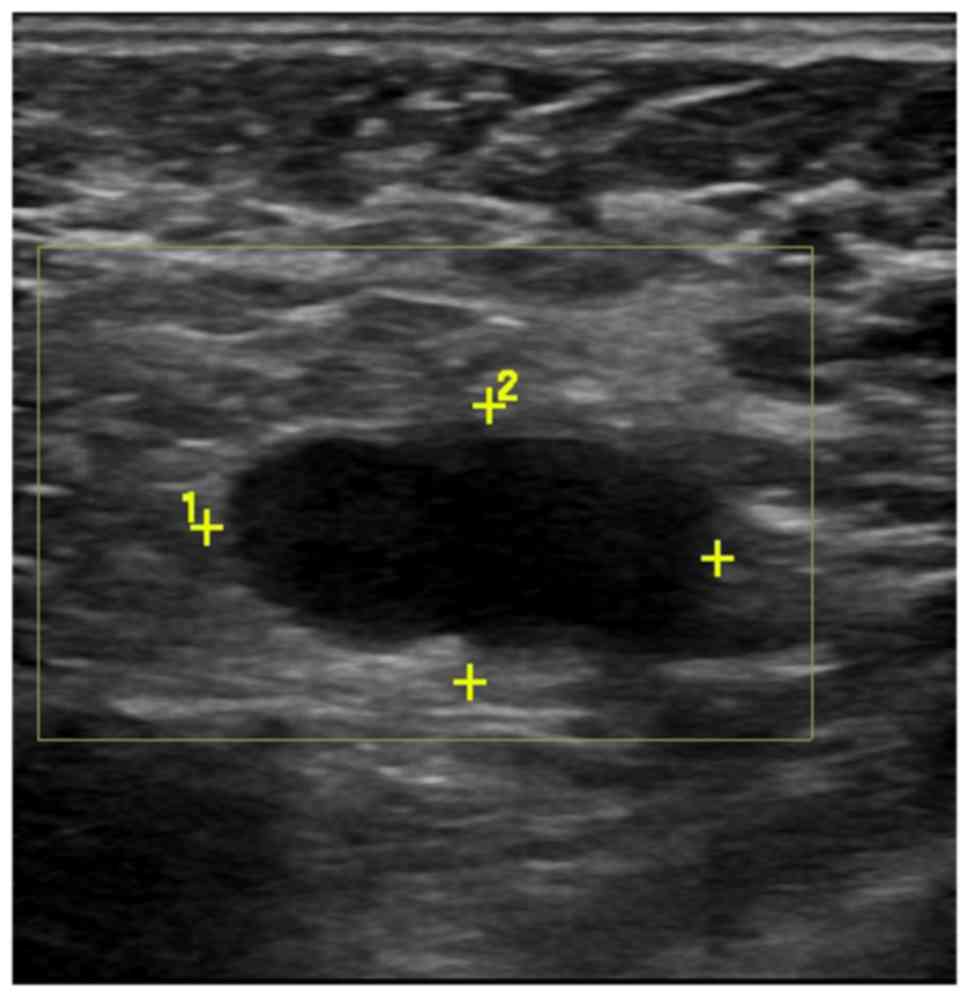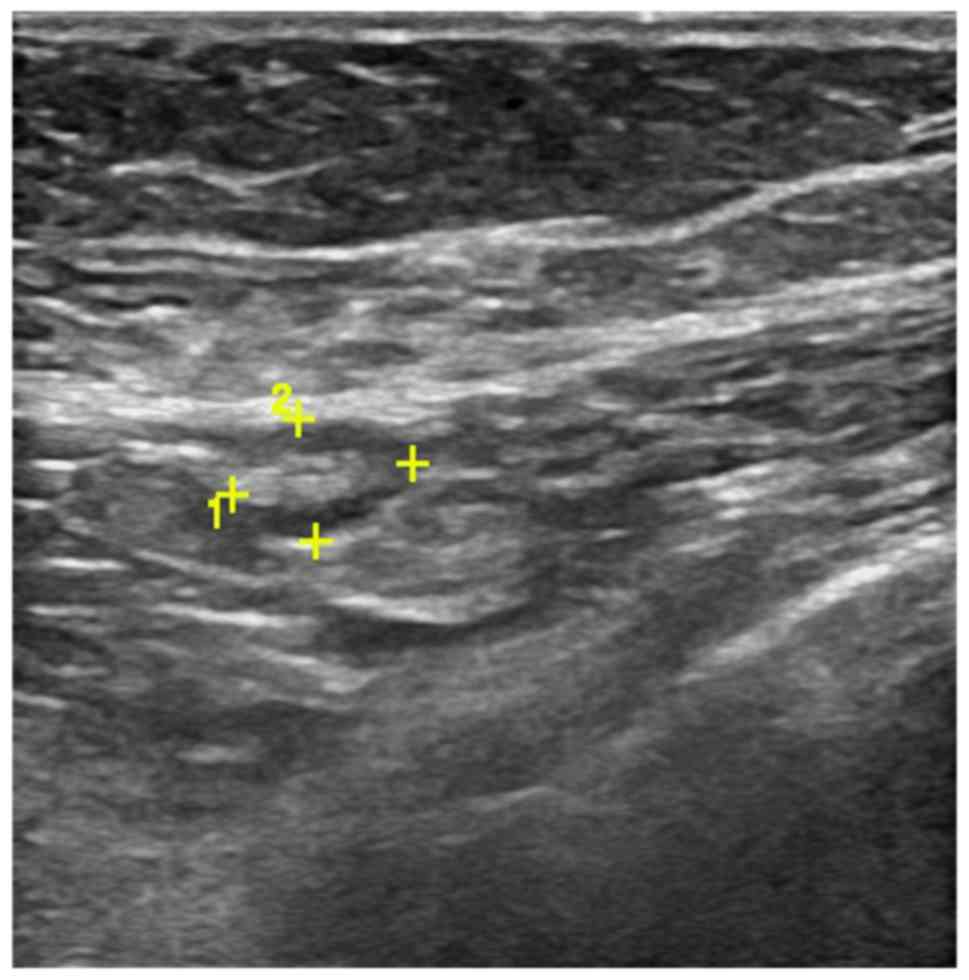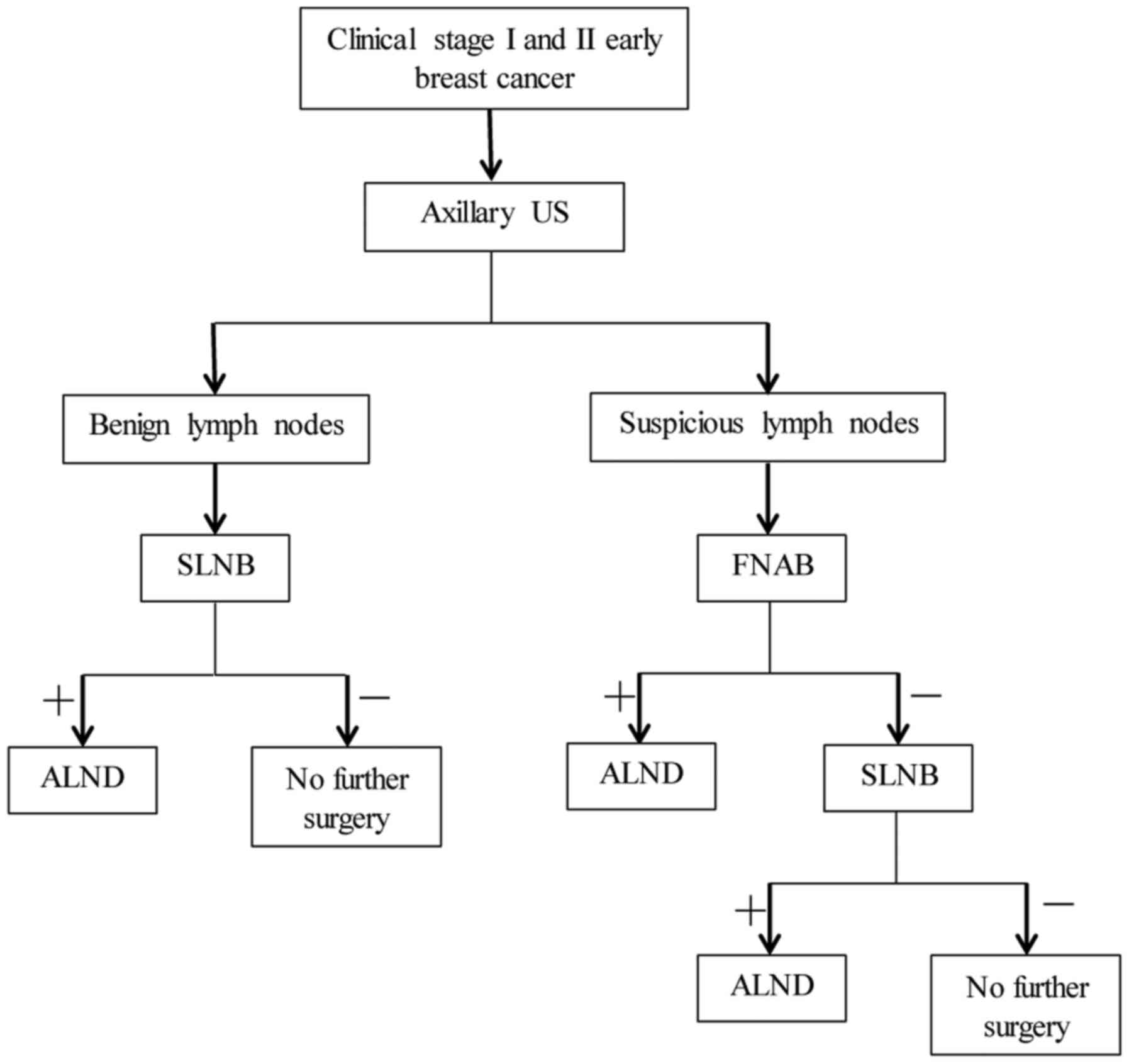|
1
|
Cianfrocca M and Goldstein LJ: Prognostic
and predictive factors in early-stage breast cancer. Oncologist.
9:606–616. 2004. View Article : Google Scholar : PubMed/NCBI
|
|
2
|
Fisher ER, Anderson S, Redmond C and
Fisher B: Pathologic findings from the national surgical adjuvant
breast project protocol B-06. 10-year pathologic and clinical
prognostic discriminants. Cancer. 71:2507–2514. 1993. View Article : Google Scholar : PubMed/NCBI
|
|
3
|
Swinson C, Ravichandran D, Nayagam M and
Allen S: Ultrasound and fine needle aspiration cytology of the
axilla in the pre-operative identification of axillary nodal
involvement in breast cancer. Eur J Surg Oncol. 35:1152–1157. 2009.
View Article : Google Scholar : PubMed/NCBI
|
|
4
|
Giuliano AE, Hunt KK, Ballman KV, Beitsch
PD, Whitworth PW, Blumencranz PW, Leitch AM, Saha S, McCall LM and
Morrow M: Axillary dissection vs no axillary dissection in women
with invasive breast cancer and sentinel node metastasis: A
randomized clinical trial. JAMA. 305:569–575. 2011. View Article : Google Scholar : PubMed/NCBI
|
|
5
|
Boland MR, Prichard RS, Daskalova I,
Lowery AJ, Evoy D, Geraghty J, Rothwell J, Quinn CM, O'Doherty A
and McDermott EW: Axillary nodal burden in primary breast cancer
patients with positive pre-operative ultrasound guided fine needle
aspiration cytology: Management in the era of ACOSOG Z011. Eur J
Surg Oncol. 41:559–565. 2015. View Article : Google Scholar : PubMed/NCBI
|
|
6
|
Moorman AM, Bourez RL, de Leeuw DM and
Kouwenhoven EA: Pre-operative ultrasonographic evaluation of
axillary lymph nodes in breast cancer patients: For which group
still of additional value and in which group cause for special
attention? Ultrasound Med Biol. 41:2842–2848. 2015. View Article : Google Scholar : PubMed/NCBI
|
|
7
|
Bedi DG, Krishnamurthy R, Krishnamurthy S,
Edeiken BS, Le-Petross H, Fornage BD, Bassett RL Jr and Hunt KK:
Cortical morphologic features of axillary lymph nodes as a
predictor of metastasis in breast cancer: In vitro sonographic
study. AJR Am J Roentgenol. 191:646–652. 2008. View Article : Google Scholar : PubMed/NCBI
|
|
8
|
Abe H, Schmidt RA, Kulkarni K, Sennett CA,
Mueller JS and Newstead GM: Axillary lymph nodes suspicious for
breast cancer metastasis: Sampling with US-guided 14-gauge
core-needle biopsy-clinical experience in 100 patients. Radiology.
250:41–49. 2009. View Article : Google Scholar : PubMed/NCBI
|
|
9
|
Boughey JC, Moriarty JP, Degnim AC, Gregg
MS, Egginton JS and Long KH: Cost modeling of preoperative axillary
ultrasound and fine-needle aspiration to guide surgery for invasive
breast cancer. Ann Surg Oncol. 17:953–958. 2010. View Article : Google Scholar : PubMed/NCBI
|
|
10
|
Pessoa EC, Rodrigues JR, Pessoa CP,
Vespoli HM and Uemura G: Axillary lymph node aspiration guided by
ultrasound is effective as a method of predicting lymph node
involvement in patients with breast cancer? Rev Bras Ginecol
Obstet. 36:118–123. 2014.(In Portuguese). View Article : Google Scholar : PubMed/NCBI
|
|
11
|
Lee MC, Eatrides J, Chau A, Han G, Kiluk
JV, Khakpour N, Cox CE, Carter WB and Laronga C: Consequences of
axillary ultrasound in patients with T2 or greater invasive breast
cancers. Ann Surg Oncol. 18:72–77. 2011. View Article : Google Scholar : PubMed/NCBI
|
|
12
|
Park SH, Kim MJ, Park BW, Moon HJ, Kwak JY
and Kim EK: Impact of preoperative ultrasonography and fine-needle
aspiration of axillary lymph nodes on surgical management of
primary breast cancer. Ann Surg Oncol. 18:738–744. 2011. View Article : Google Scholar : PubMed/NCBI
|
|
13
|
Baruah BP, Goyal A, Young P, Douglas-Jones
AG and Mansel RE: Axillary node staging by ultrasonography and
fine-needle aspiration cytology in patients with breast cancer. Br
J Surg. 97:680–683. 2010. View
Article : Google Scholar : PubMed/NCBI
|
|
14
|
van Roozendaal LM, Vane MLG, van Dalen T,
van der Hage JA, Strobbe LJA, Boersma LJ, Linn SC, Lobbes MBI,
Poortmans PMP, Tjan-Heijnen VCG, et al: Clinically node negative
breast cancer patients undergoing breast conserving therapy,
sentinel lymph node procedure versus follow-up: A Dutch randomized
controlled multicentre trial (BOOG 2013–08). BMC Cancer.
17:4592017. View Article : Google Scholar : PubMed/NCBI
|
|
15
|
Cyr AE, Tucker N, Ademuyiwa F,
Margenthaler JA, Aft RL, Eberlein TJ, Appleton CM, Zoberi I, Thomas
MA, Gao F and Gillanders WE: Successful completion of the pilot
phase of a randomized controlled trial comparing sentinel lymph
node biopsy to no further axillary staging in patients with
clinical T1-T2 N0 breast cancer and normal axillary ultrasound. J
Am Coll Surg. 223:399–407. 2016. View Article : Google Scholar : PubMed/NCBI
|
|
16
|
Gentilini O and Veronesi U: Abandoning
sentinel lymph node biopsy in early breast cancer? A new trial in
progress at the European Institute of Oncology of Milan (SOUND:
Sentinel node vs. observation after axillary ultrasound. Breast.
21:678–681. 2012. View Article : Google Scholar : PubMed/NCBI
|
|
17
|
Nenutil R: A revolution postponed
indefinitely. WHO classification of tumors of the breast 2012: The
main changes compared to the 3rd edition (2003). Cesk Patol.
51:23–25. 2015.PubMed/NCBI
|
|
18
|
Murray AD, Staff RT, Redpath TW, Gilbert
FJ, Ah-See AK, Brookes JA, Miller ID and Payne S: Dynamic contrast
enhanced MRI of the axilla in women with breast cancer: Comparison
with pathology of excised nodes. Br J Radiol. 75:220–228. 2002.
View Article : Google Scholar : PubMed/NCBI
|
|
19
|
Bonnema J, van Geel AN, van Ooijen B, Mali
SP, Tjiam SL, Henzen-Logmans SC, Schmitz PI and Wiggers T:
Ultrasound-guided aspiration biopsy for detection of nonpalpable
axillary node metastases in breast cancer patients: New diagnostic
method. World J Surg. 21:270–274. 1997. View Article : Google Scholar : PubMed/NCBI
|
|
20
|
Oruwari JU, Chung MA, Koelliker S,
Steinhoff MM and Cady B: Axillary staging using ultrasound-guided
fine needle aspiration biopsy in locally advanced breast cancer. Am
J Surg. 184:307–309. 2002. View Article : Google Scholar : PubMed/NCBI
|
|
21
|
Chang MC, Crystal P and Colgan TJ: The
evolving role of axillary lymph node fine-needle aspiration in the
management of carcinoma of the breast. Cancer Cytopathol.
119:328–334. 2011. View Article : Google Scholar : PubMed/NCBI
|
|
22
|
Kuenen-Boumeester V, Menke-Pluymers M, de
Kanter AY, Obdeijn IM, Urich D and Van Der Kwast TH:
Ultrasound-guided fine needle aspiration cytology of axillary lymph
nodes in breast cancer patients. A preoperative staging procedure.
Eur J Cancer. 39:170–174. 2003. View Article : Google Scholar : PubMed/NCBI
|
|
23
|
Ciatto S, Brancato B, Risso G, Ambrogetti
D, Bulgaresi P, Maddau C, Turco P and Houssami N: Accuracy of fine
needle aspiration cytology (FNAC) of axillary lymph nodes as a
triage test in breast cancer staging. Breast Cancer Res Treat.
103:85–91. 2007. View Article : Google Scholar : PubMed/NCBI
|
|
24
|
Krishnamurthy S, Sneige N, Bedi DG,
Edieken BS, Fornage BD, Kuerer HM, Singletary SE and Hunt KK: Role
of ultrasound-guided fine-needle aspiration of indeterminate and
suspicious axillary lymph nodes in the initial staging of breast
carcinoma. Cancer. 95:982–988. 2002. View Article : Google Scholar : PubMed/NCBI
|
|
25
|
Davis JT, Brill YM, Simmons S, Sachleben
BC, Cibull ML, McGrath P, Wright H, Romond E, Hester M, Moore A and
Samayoa LM: Ultrasound-guided fine-needle aspiration of clinically
negative lymph nodes vs. sentinel node mapping in patients at high
risk for axillary metastasis. Ann Surg Oncol. 13:1545–1552. 2006.
View Article : Google Scholar : PubMed/NCBI
|
|
26
|
Leenders MW, Broeders M, Croese C, Richir
MC, Go HL, Langenhorst BL, Meijer S and Schreurs WH: Ultrasound and
fine needle aspiration cytology of axillary lymph nodes in breast
cancer. To do or not to do? Breast. 21:578–583. 2012. View Article : Google Scholar : PubMed/NCBI
|
|
27
|
García Fernández A, Fraile M, Giménez N,
Reñe A, Torras M, Canales L, Torres J, Barco I, González S, Veloso
E, et al: Use of axillary ultrasound, ultrasound-fine needle
aspiration biopsy and magnetic resonance imaging in the
preoperative triage of breast cancer patients considered for
sentinel node biopsy. Ultrasound Med Biol. 37:16–22. 2011.
View Article : Google Scholar : PubMed/NCBI
|
|
28
|
Popli MB, Sahoo M, Mehrotra N, Choudhury
M, Kumar A, Pathania OP and Thomas S: Preoperative
ultrasound-guided fine-needle aspiration cytology for axillary
staging in breast carcinoma. Australas Radiol. 50:122–126. 2006.
View Article : Google Scholar : PubMed/NCBI
|
|
29
|
Tahir M, Osman KA, Shabbir J, Rogers C,
Suarez R, Reynolds T and Bucknall T: Preoperative axillary staging
in breast cancer-saving time and resources. Breast J. 14:369–371.
2008. View Article : Google Scholar : PubMed/NCBI
|
|
30
|
Deurloo EE, Tanis PJ, Gilhuijs KG, Muller
SH, Kröger R, Peterse JL, Rutgers EJ, Olmos Valdés R and Kool
Schultze LJ: Reduction in the number of sentinel lymph node
procedures by preoperative ultrasonography of the axilla in breast
cancer. Eur J Cancer. 39:1068–1073. 2003. View Article : Google Scholar : PubMed/NCBI
|
|
31
|
Gilissen F, Oostenbroek R, Storm R,
Westenend P and Plaisier P: Prevention of futile sentinel node
procedures in breast cancer: Ultrasonography of the axilla and
fine-needle aspiration cytology are obligatory. Eur J Surg Oncol.
34:497–500. 2008. View Article : Google Scholar : PubMed/NCBI
|
|
32
|
MacNeill M, Arnott I and Thomas J: Fine
needle aspiration cytology is a valuable adjunct to axillary
ultrasound in the preoperative staging of breast cancer. J Clin
Pathol. 64:42–46. 2011. View Article : Google Scholar : PubMed/NCBI
|
|
33
|
van Rijk MC, Deurloo EE, Nieweg OE,
Gilhuijs KG, Peterse JL, Rutgers EJ, Kröger R and Kroon BB:
Ultrasonography and fine-needle aspiration cytology can spare
breast cancer patients unnecessary sentinel lymph node biopsy. Ann
Surg Oncol. 13:31–35. 2006. View Article : Google Scholar : PubMed/NCBI
|
|
34
|
Mainiero MB: Regional lymph node staging
in breast cancer: The increasing role of imaging and
ultrasound-guided axillary lymph node fine needle aspiration.
Radiol Clin North Am. 48:989–997. 2010. View Article : Google Scholar : PubMed/NCBI
|
|
35
|
Sapino A, Cassoni P, Zanon E, Fraire F,
Croce S, Coluccia C, Donadio M and Bussolati G:
Ultrasonographically-guided fine-needle aspiration of axillary
lymph nodes: Role in breast cancer management. Br J Cancer.
88:702–706. 2003. View Article : Google Scholar : PubMed/NCBI
|
|
36
|
Abe H, Schmidt RA, Sennett CA, Shimauchi A
and Newstead GM: US-guided core needle biopsy of axillary lymph
nodes in patients with breast cancer: Why and how to do it.
Radiographics. 27 Suppl 1:S91–S99. 2007. View Article : Google Scholar : PubMed/NCBI
|
|
37
|
Koelliker SL, Chung MA, Mainiero MB,
Steinhoff MM and Cady B: Axillary lymph nodes: US-guided
fine-needle aspiration for initial staging of breast
cancer-correlation with primary tumor size. Radiology. 246:81–89.
2008. View Article : Google Scholar : PubMed/NCBI
|
|
38
|
Pigott J, Nichols R, Maddox WA and Balch
CM: Metastases to the upper levels of the axillary nodes in
carcinoma of the breast and its implications for nodal sampling
procedures. Surg Gynecol Obstet. 158:255–259. 1984.PubMed/NCBI
|

















